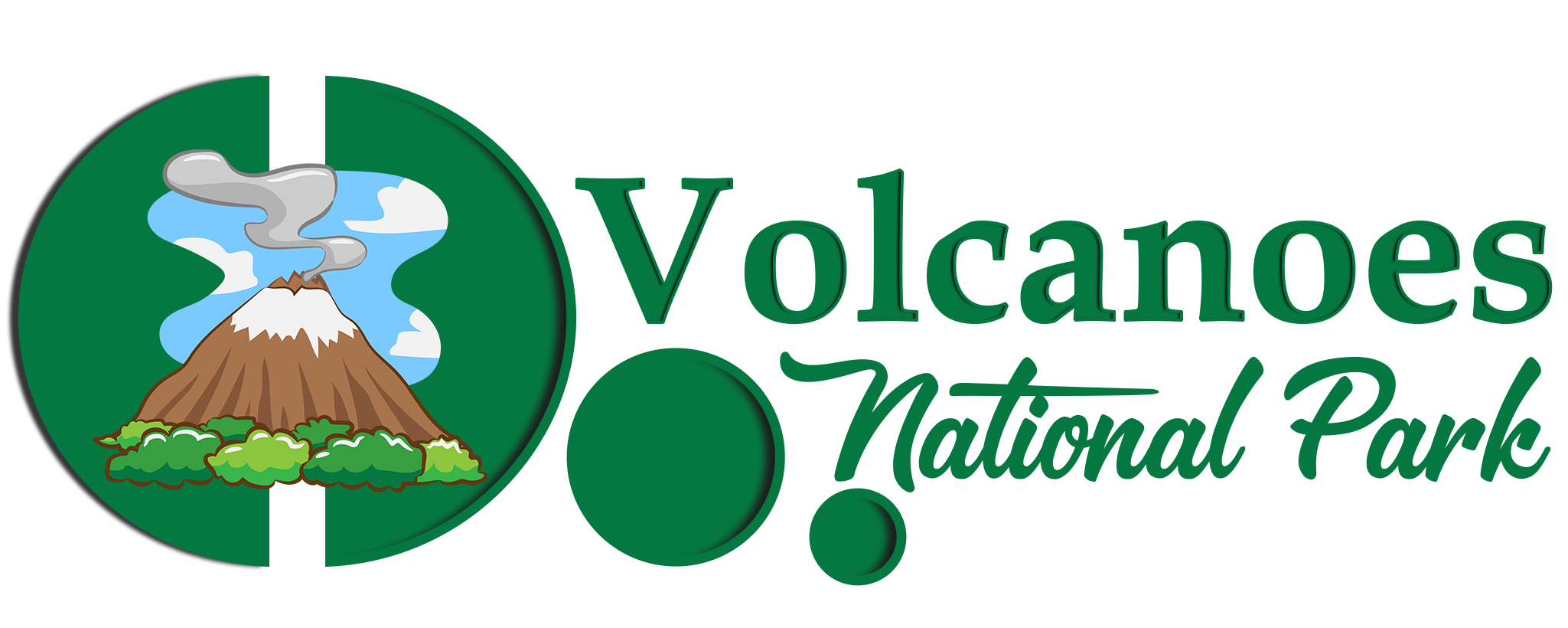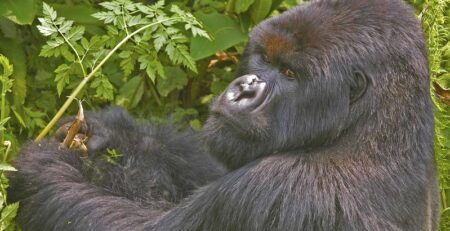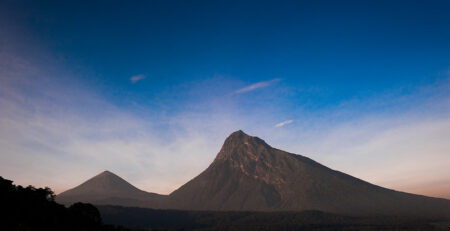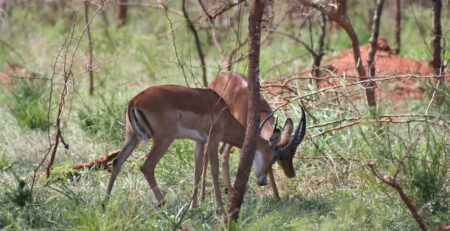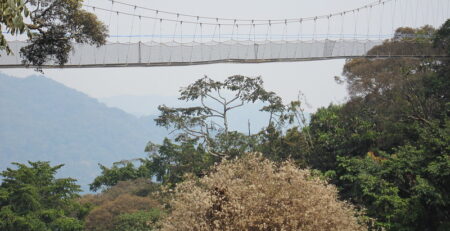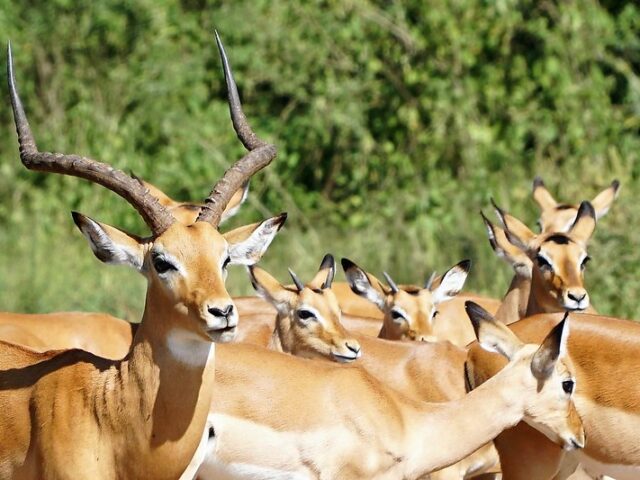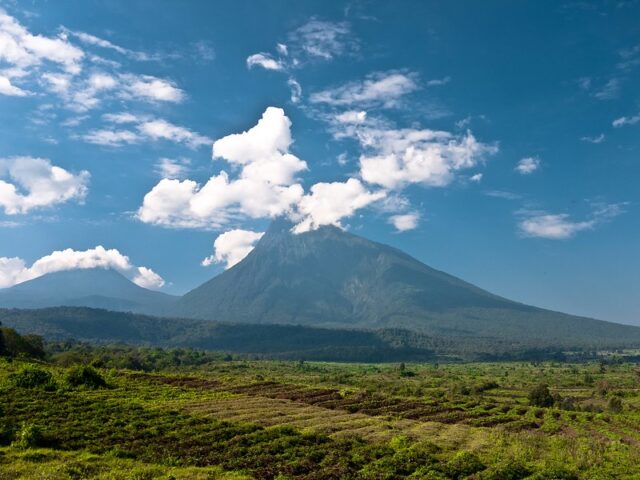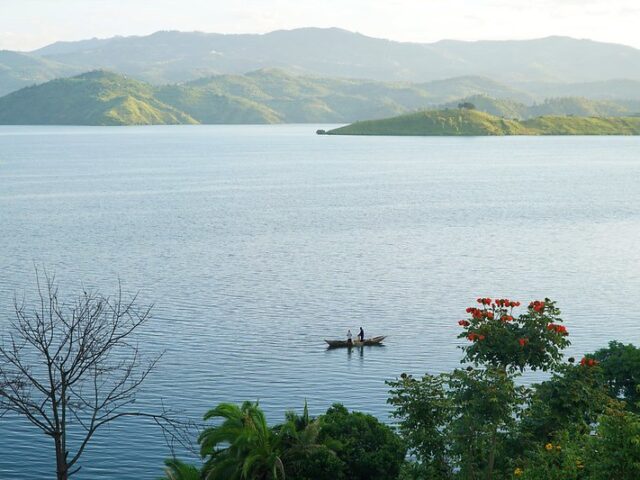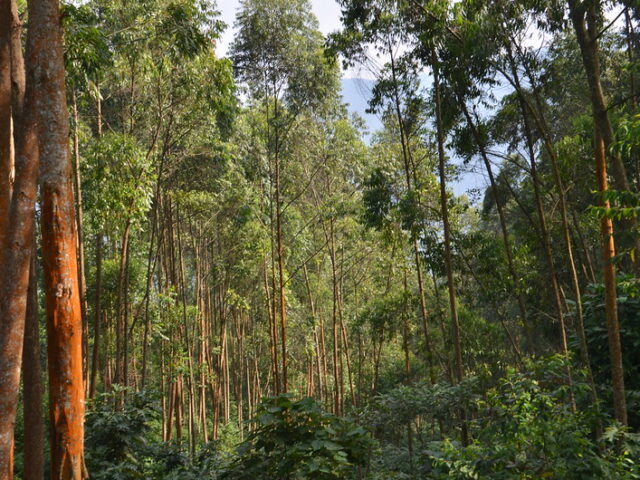Volcanoes National Park
The Virunga Volcanoes Paradise
Volcanoes National Park In Rwanda is givem a name after the famous chain of dormant and huge volcanoes making up the Virunga Massif commonly known the Virunga conservation area: Karisimbi – the highest at 4,507m, Bisoke with its verdant crater lake, Sabinyo, Gahinga and Muhabura.
Mountain Gorilla
Primate Trekking In Rwanda
Rwanda is famous for its gorillas in Volcanoes National Park, but the country also has chimps and a variety of monkeys, including colobus, golden, L’Hoest’s, owl faced, Dent’s, blue, and vervet, as well as olive baboons and the nocturnal potto and bushbabies.
Popular Safaris In Volcanoes
Guide To Volcanoes National Park In Rwanda Safaris
Primate Trekking In Rwanda | Virunga Volcanoes | Dian Fossey | Gorilla Safaris
Volcanoes National Park, commonly known as Parc National de Volcans (PNV) is situated in the north western province of Rwanda in Musanze town which used to be known as Ruhengeri. The park was established in 1925 thus being one of the oldest National Parks in Africa. The park is a habitant to the endangered mountain gorillas being the major tourist attraction. A complex mosaic of montane ecosystems, including evergreen and bamboo forest, open grassland, marsh, and heath, may be found in Volcanoes National Park.
Volcanoes National Park boarders with the Virunga National Park in the Democratic Republic of the Congo and the Mgahinga National Park in Uganda. The three parks come together to form the Virunga conservation region, which was created primarily to safeguard the critically endangered mountain gorillas.
Mountain gorillas can only be found in three countries in Africa and that’s Rwanda, Uganda and the Democratic Republic of Congo. In Rwanda they can be seen in Volcanoes National Park which hosts about 12 habituated gorilla families.
The famed primatologist Dian Fossey described the Virungas, “great, old volcanoes towering almost 15,000 feet, and almost completely covered with rich, verdant rain forest. They are in the center of Central Africa, so high up that you shiver more than you sweat.” The late Dian Fossey focused her life’s work on the protection and conservation of mountain gorillas. At the Kari-soke Research Center in Rwanda’s Volcanoes National Park, Dian Fossey conducted studies on mountain gorillas. Her 18-year research of mountain gorillas led to the development of gorilla tourism, which helped greatly in the preservation of the species. The critically acclaimed movie “Gorillas in the Mist,” which was filmed in Volcanoes National Park, features a significant portion of her work.
In addition to the critically endangered mountain gorillas, the Volcanoes National Park is notable for its steep terrain, lush forests, lakes, rivers, and sizable populations of other animals. The Volcanoes National Park is home to five of the eight Virunga significant volcanoes. They are Bisoke (3,711 meters), Karisimbi (4,507 meters), Gahinga (3,474 meters), Sabyinyo (3,634 meters), and Muhabura (4,127 meters). The park features distinct kinds of plant life, including bamboo on the lower slopes, hypericum / hagianum on the upper elevations below 3,300m, sub-alpine vegetation above 3,300m, and afro alpine vegetation above 4,000m. This is because to the high altitudes, volcanoes, and low-lying places.
Apart from hosting part of the existing mountain gorilla population size, which subsists on growing bamboo and other lower-elevation flora, the parks lower altitudes are also home to the stunning golden monkeys, another endangered species. The park is also habitat to untamed chimpanzees along with other monkeys such as vervet and colobus monkeys. Although in tiny groups, larger creatures like forest Elephants and Buffaloes can be encountered. Leopards, Bushbucks, Duikers, Bush Pigs, Forest Hogs, and Spotted Hyenas can all be found in the park.
More than 200 different bird species can be seen at Volcanoes National Park, including some endemics to the Albertine Rift that are enjoyed by bird watchers. The Rwenzori batis, Grauer’s rush warbler, handsome fancolin, Rwenzori turaco, collared Apalis, Rwenzori double-collared Sunbird, unusual weaver, dusky crimson-wing, red-faced woodland warbler, and Archer’s ground robin are a few of the species to keep an eye out for.
The most popular activity in Rwanda’s Volcanoes National Park is mountain gorilla trekking, but there are a variety of other exotic adventures available as well such as golden monkey tracking, volcano hiking, visiting the twin lakes of Ruhondo and Burera, Community tour like Iby’iwacu village, Visiting Dian Fossey’s tomb among others that will give you an unforgettable experience.
Volcanoes National Park which is part of the great Virunga massif covers an area of 160kms and it’s located about 105km from Kigali International airport which is approximately 2 hours and a half drive. The park is as well close to Akagera National Park which favors travelers who want to combine gorilla trekking with wildlife safari experience in Rwanda.
Volcanoes National Park can be visited for expeditions all year round, but tourists choose the driest months. The dry months, from June through August, and from December through February, happen twice a year. The average temperature rise during summertime is 16 degrees, and the overnight low might reach 6 degrees Celsius. It is difficult to hike in the park during the wet months of March, April, and May, as well as October through November, because of the frequent downpours that turn the surfaces muddy and render the slopes slick.
There are numerous lodging options in the Volcanoes National Park, for all preferences, budgets, and trip kinds, ranging from cozy safari lodges to leisurely tented camps. Don’t be worried about your accommodation on the safari to Kigali. Adventure in the wild gives you a number of lodging facilities among others they include, Volcanoes virunga lodge, Mountain gorilla view lodge, Wilderness Sabyinyo and Kataza house.
Volcanoes National Park was gazetted in 1925 and is situated in the Northwestern part of Rwanda. Volcano consists five of the eight volcanoes of Virunga massif and it borders Virunga National Park in the Democratic Republic of Congo and Mgahinga National Park in Uganda. Mountain gorillas are a main draw, and a lot of visitors to VNP prioritize going on a gorilla trek. Golden monkeys, the Dian Fossey Grave, birds in the park, the Virunga Volcanoes, the twin lakes of Burera and Ruhondo, community and cultural tours, among other things, are some of the park’s tourist attractions. These elements come together to create a comprehensive Rwanda safari package that will provide you with lifelong memories.
Mountain gorillas
Just a few percent of the protected afro montane forests of northwest Rwanda, southwest Uganda, and eastern DRC are home to mountain gorillas, the most endangered primate in the world. One of the many creatures that are exclusive to these woods is the mountain gorilla. The dense forests also provide a haven for a variety of beautiful birds, monkeys, huge mammals, reptiles, insects, and plants, as well as a steady supply of water and medicinal herbs for the nearby towns.
Only three countries in Africa that’s to say, Uganda in Mgahinga National Park and Bwindi Impenetrable Forest, Rwanda in Volcanoes National Park and the Democratic Republic of Congo in Virunga National Park are home to over half of the 700 mountain gorillas that exist today.
Although gorillas may climb trees, they often live on the ground and in groups. These troops are set up in interesting social hierarchies. One dominating, older adult male, known as a silver back because of the silver hair that adorns his usually dark fur, leads the troops. Numerous other young males, some females, and their progeny are also included in the troops. Activities such as feeding, building leaf nests, and wandering around the home range are coordinated by the leader. Compared to their relatives the lowlands, mountain gorillas have arms that are shorter and longer hair. They also frequently have a bigger stature than other gorillas.
The six Virunga Volcanoes and the renowned mountain gorillas are found in the 125 km2 mountain forest that makes up Volcanoes National Park. The spectacular surroundings for gorilla trekking, possibly the most moving and unforgettable wildlife encounter anywhere in the world, is the mountains’ lushly forested slopes.
The trackers get lost in the mystical familiarity of the rain forest, filled by the songs of vibrant birds and the conversation of rare golden monkeys, as they ascend the exciting bamboo forest path to the gorillas’ native home. Nothing can sufficiently prepare a person for the impact of coming into contact with an entirely grown silver back gorilla, which is astonishingly peaceful and accommodating of human visitors despite being up to three times the dimensions of an average man.
Golden monkeys
There are at present two habituated golden monkey teams in Volcanoes National Park that are open for visitors to the region. These uncommon species are also designated as endangered.
In Rwanda, golden monkeys can be found in the bamboo forest in the volcanoes. Habituation has assisted them get over their original nervousness and tolerate the frequent presence of tourists and researchers. Both golden monkey and gorilla trekking involve small groups of not more than eight people, and after you locate the monkeys, you are allowed to spend an hour with them. The creatures of the endangered species are quite active and bounce from tree to tree, which is really fascinating but a little challenging to capture on camera.
If your passion is in animals, the golden monkey hike is a unique and beautiful adventure not to be missed while visiting Volcanoes National Park. In addition to Volcanoes National Park, Mgahinga Gorilla National Park is home to another colony of golden monkeys in south-western Uganda.
Twin lakes of Ruhondo and Burera
Since they are physically connected and share a location, the twin lakes of Burera and Ruhondo were given that name. They may be reached by foot from the Volcanoes National Park and are situated in the Musanze district at the foot of Mount Muhabura. The lakes provide visitors with a stunning perspective of the surroundings, including wetlands, indigenous populations, the Virunga volcanoes, and tourist destinations in neighboring Uganda and the Democratic Republic of the Congo.
Along with stunning views of the lush foliage and some small birds on the water’s edge, the canoe trip also rewards tourists with a breath of fresh air. Fortunately, the lakes are devoid of venomous aquatic creatures like crocodiles, guaranteeing guests’ safety on the water. Additionally, visitors get the opportunity to converse with locals who are also riding as they pass to their gardens. It’s such a fascinating experience that no traveler should skip it.
The volcanic explosion in the Virunga massif is what created the twin lakes. The two lakes are thought to have developed as a result of the river Nyabarongo being blocked by volcanic glaciers from the erupting volcanoes as it flowed towards the northern section of Rwanda. The verdant foliage that surrounds these water basins gives the lake waters their green appearance, adding to its wonderful appearance.
It’s interesting to note that the two lakes also have islands that can be reached by boat. A spot on an island is ideal for sightseeing and taking pictures. It is simple for a traveler to combine a boat ride at the twin lakes with other activities like gorilla trekking because this activity is best performed in the afternoon. People who live on the island extend a warm welcome to visitors. Additionally, locals educate visitors about the customs, habits, and norms of Rwanda, deepening their awareness of
Virunga Volcanoes
Mount Bisoke, Karisimbi, Sabinyo, Gahinga, and Muhabura are the five of the eight virunga volcanoes that are located in Volcanoes National Park. These provide wonderful trekking experiences with stunning views of the surroundings. Any one of these summits can be climbed for breathtaking views of the park’s environment, wildlife, birds, and plants. Each of the above volcanic mountains can be reached via a different climb, and every hike is incredibly gratifying in a unique manner.
Mt. Karismbi is the tallest of the eight major volcanoes in the Virunga massif. It rises to a height of around 4507 meters above sea level. Reaching the summit of Karisimbi, from which you can see Mount Nyiragongo, Mount Muhabura, and Mount Nyamuragira, might take up to two days of hiking. Depending on the length of the hike, hiking can take anywhere from 5 to 6 hours. No prior hiking experience is necessary, but one must be physically fit to hike for hours over hills. The most popular and intriguing volcano for day hikers is Mount Bisoke since you may ascend to the top and observe the crater lake before returning. Depending on the pace at which you walk and how dry the terrain is, the Mount Bisoke hike lasts anywhere from 5-7 hours in total. Other hikes lead to Mount Sabyinyo and Mount Muhabura.
Caves
The Musanze caverns are shaped like a house and have numerous corridors. They are situated on the steep slopes of Volcanoes National Park. The Virunga volcanoes’ associated eruptions is what created these caverns. They were created from the balsamic lava layers of the Bisoke and Sabinyo volcanoes. The main entrance to the caves is 2 km wide and has numerous paths going in and out. When you visit Volcanoes National Park, you will learn about the origins and formation of these caverns. The caves are beautiful and ideal for taking pictures.
Dian Fossey’s grave
Visitors to Rwanda’s Volcanoes National Park should not skip a hike to Dian Fossey’s grave, which is situated close to the Karisoke research site she founded between the Bisoke and Karisimbi volcanoes. Dian Fossey was a primatologist who arrived in 1967 and worked on mountain gorilla research for almost 20 years. With her efforts poaching reduced in the area, Unfortunatel, she was killed by poachers in 1985. She was interred close to Digit, her favorite gorilla. You may still see Digit’s grave and that of other murdered gorillas when you visit her burial. It takes roughly six hours to hike to and from Dian Fossey’s burial. You will discover more about her life, her work, and the legacy she has left.
Genocide sites
It is impossible to visit Rwanda without learning about its painful Genocide history. The tale of the massacre depicts the widespread murder of members of Rwanda’s two ethnic groups, the Tutsi and the Hutus. The brutal killing started on April 6th, 1994, and continued for 100 days. The genocide was a result of misunderstandings between the Hutu and the Tutsi due to cultural differences and various reasons. After the genocide, a memorable site was created in Rwanda which now became a tourist attraction.
Vegetation
The wonderful gorilla trekking site in Rwanda, Volcanoes National Park, has a wide variety of vegetation that supports a wide range of mammal and bird species. Rain forest, thickets, marshes, swamps, grasslands, alpine forests, and meadows at various altitudinal ranges make up the vegetation in Volcanoes National Park. These include a bamboo forest, an arundinaria alphia forest, and a canopy of rain forests in the ranges between 2400 and 2500 meters. Over 30% of the total land area is covered by a bamboo forest. The moist slopes in the south and west of the park are carpeted with hypericum forest from 2600 to 3600 meters above sea level, making up around 30% of the entire park’s total land area. One of Hagena Abyssinia’s greatest forests is this one.
The forest, which makes up roughly 24% of the park’s land, is distinguished by Lobelia wollastonii, L. Laurens, and Senecio erici-rosenii between 3500 and 4500 meters. The park is covered in grassland from 4300 to 4500 meters, providing a haven for numerous bird species.
Wildlife
Animal and bird habitation is favored by a variety of vegetation cover. Mountain gorillas are the main attraction for the majority of visitors on Rwanda safaris, and Volcanoes National Park is well renowned for having them. Along with gorillas, the park is also home to several other endangered species such as the golden monkeys. Other animals includes forest elephants, bushpigs, duikers, spotted hyenas, buffaloes, forest hogs, etc.
Bird life
The park is a sanctuary for birders, with more than 200 species of birds living there. Visitors can visit Virunga to watch a variety of bird species in this wonderful forest. Birdwatching is best done while taking a stroll through a forest, where visitors may take in the pleasant sounds of birds singing high in the treetops. The odd weaver, Red-faced woodland warbler, Archer’s ground robin, dusky crimson-wind, Francolins, Rwenzori batis, Rwenzori double collared sunbird, and Rwenzori Turaco are just a few of the birds to look out for at Volcanoes National Park. You can find these birds and learn about the specific characteristics of each bird species from knowledgeable birding guides.
Popular Safaris
All About QENP
- History Of The Park
- Things To Do
- Places To See
- Getting There
Other National Parks & Reserves To Visit In Uganda
Queen Elizabeth National Park
A Medley Of Wonders
Bwindi Impenetrable National Park
The Ultimate Gorilla Experience
Murchison Falls National Park
The World's Most Powerful Waterfall
Mount Rwenzori National Park
The Mystical Challenge
Travel Stories, Articles & Tips
Why Visit Rwanda
Why Visit Rwanda The nation offers breathtaking hiking and trekking opportunities through tropical rainforests to volcanic peak summits and even above the tree canopy. You can always find incredible animals, both...
Mount Nyamuragira
MOUNT NYAMURAGIRA Mount Nyamuragira is located in Virunga national park in the Democratic Republic of Congo. It is one of the eight mountains that make up the Virunga massif situated only...
Lake Kivu
Lake Kivu One of the Great Lakes of Africa is Lake Kivu. It is located in the Albertine Rift, the western arm of the East African Rift, and is on the...
Hiking Trails In Nyungwe Forest National Park
Hiking Trails In Nyungwe Forest National Park The Nyungwe Forest National Park in Rwanda has 130 kilometers of hiking routes. You might easily spend a week here while hiking through the...
